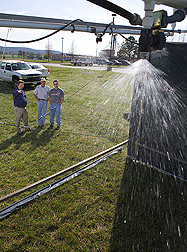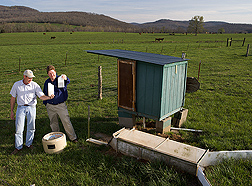Alum Curbs Phosphorus Runoff and More
|
|
Poultry litter—a mixture of chicken manure, feathers, spilled food, and bedding material—is an inexpensive and popular fertilizer because it contains nitrogen and phosphorus. But applying more fertilizer than a crop needs can lead to buildup of phosphorus in the soil. Runoff from these fields can increase populations of blue-green algae and undesirable aquatic plants that rob water of oxygen, causing fish kills and odor and taste problems in municipal water supplies.
An exciting development from Agricultural Research Service scientists shows that poultry litter doesn’t have to be a significant pollution source if proper application guidelines are followed.
Testing a Low-Cost Solution
In 1992, Philip Moore, a soil scientist in the ARS Poultry Production and Product Safety Research Unit at Fayetteville, Arkansas, first discovered that alum (aluminum sulfate) applied to poultry litter greatly reduces phosphorus runoff from pastures. Alum binds to phosphate, forming aluminum phosphate, which is less susceptible to losses in runoff.
Soon after, Moore found that alum could reduce ammonia emissions in poultry houses. A patent was granted for alum-treatment of poultry litter in 1997, and it was licensed and commercially marketed the following year.
Although alum’s short-term benefits are now well documented, its long-term effects are not. That’s why Moore and Dwayne Edwards, an agricultural engineer at the University of Kentucky-Lexington, began two 20-year studies in the mid-1990s to evaluate the effects of alum.
The researchers are studying paired 1-acre watersheds in a commercial beef and broiler chicken operation, along with 52 small plots on university land. They’re comparing nutrient runoff following applications of alum-treated poultry litter, untreated poultry litter, and ammonium nitrate, the most common commercial nitrogen fertilizer.
The two watersheds, separated by earthen berms, are similar in size, slope, and land cover and receive uniform treatment.Every time it rains, runoff volume is automatically monitored and runoff samples are taken.
Working Wonders for Soil, Water, Air
The results of the first 10 years of the study are now in, and the news is better than expected: Applying alum-treated litter reduced phosphorus runoff by 75 percent at the watershed scale and as much as 87 percent from the small plots.
Researchers also found that alum reduced ammonia levels in poultry houses by about 70 percent. This is important because ammonia reduces birds’ weight and makes them more susceptible to viruses. And alum is known to reduce pathogens in litter and on birds, further contributing to a healthier environment for both workers and birds.
Field trials conducted at commercial broiler farms in conjunction with the U.S. Environmental Protection Agency showed that alum lowered litter pH during the first 3 to 4 weeks of chick growth. The lower pH resulted in less ammonia evaporating, or volatilizing, from the litter. Laboratory studies confirmed that alum is one of the most effective compounds for reducing ammonia volatilization.
“Less ammonia means healthier, heavier birds,” Moore says. “It also leads to lower energy bills because less ventilation is needed.”
Good for Crops, Too
During the sixth year of the 20-year study, Moore noticed severe yield reductions in tall fescue fertilized with ammonium nitrate. He found that the cause was aluminum toxicity. But why would ammonium nitrate—which contains no aluminum—cause aluminum toxicity?
“Aluminum availability in soil is not controlled by the total amount of aluminum present,” Moore explains, “but by the soil’s chemical conditions, particularly pH.” Ammonium nitrate acidified the soil—lowered its pH—and increased aluminum’s availability in the soil.
On the other hand, applications of either untreated or alum-treated poultry litter raised soil pH, which reduced aluminum’s availability, compared to unfertilized controls. Although alum applications initially lower the pH of the litter, the manure from the birds increases that pH over time to around 7.5.
Forage yields were higher with alum-treated litter than with untreated poultry litter or ammonium nitrate, and use of alum didn’t affect aluminum uptake by plants or aluminum runoff.
“Yieldsof tall fescue fertilized with alum-treated litter were higher,” Moore says. “Grass tissue analyses indicated that the good yields were due to increased nitrogen availability, since alum-treated litter contains more nitrogen than untreated litter. We hypothesized that this was because of reduced ammonia volatilization.”
In previous studies by Moore and colleagues, alum-treated litter reduced runoff of heavy metals—such as arsenic, copper, and zinc—by about 40-50 percent and of naturally occurring estrogen by 42 percent.
This research indicates that alum-treated poultry litter can be a long-term, sustainable solution to the phosphorus runoff problem. Alum is one of the few cost-effective “best management practices” that improves air, soil, and water quality while increasing both poultry production and crop yields. Each year, over 600 million broilerchickens are grown with alum, and its use is rapidly expanding.—By Jim Core, formerly with ARS.
This research is part of Manure and Byproduct Utilization, an ARS National Program (#206) described on the World Wide Web at www.nps.ars.usda.gov.
Philip A. Moore, Jr., is in the USDA-ARS Poultry Production and Product Safety Research Unit, University of Arkansas, Plant Sciences Bldg., Room 115, Fayetteville, AR 72701; phone (479) 575-5724, fax (479) 575-7465.
"Alum Curbs Phosphorus Runoff and More" was published in the November/December 2006 issue of Agricultural Research magazine.








